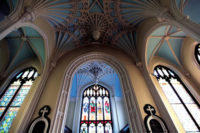
How unique is it for an architect to consider a product other than the one he or she specified? According to Todd Keel, it’s not a practice that generally happens. So when the New Spring Child and Youth Buildings, in Anderson, S.C., selected EIFS over using precast concrete, it was to the architect’s credit to agree with the contractors that EIFS was a viable solution.
Keel, owner of Upstate Stucco & Stone, LLC, has seen all the different points of view since his time in the wall and ceiling industry: as a sales rep, a distributor and now presently working as an applicator. His Greenville, S.C.-based company began 12 years ago and solely focuses as a subcontractor in both the residential and commercial markets for western South Carolina and at times beyond. Keel’s company specializes in EIFS, stucco, interior plaster and Cultured Stone. The company also has a foam coating system that it uses for ornamental pieces.

“We concentrate on commercial and instructional,” Keel says. “We also do about four or five custom homes per year with preferred builders, and have worked on several condo and apartment complexes throughout the Greenville area.”
Like other contractors, business is down, and he states that the market is “a little soft.” He says it’s been six months since work has slowed down yet he’s hoping in another six months things will pick up.
“We’re not dead but … we’re not bidding as much as this time last year. And of course we have a lot more competition. In areas like Atlanta, when they slow down, they travel,” Keel says.
Keel is also active with the CLAPCA, serving as its vice president. He reports that the association is revamping its goals. He is eager to cite the association’s mission statement: “Our mission is to promote the highest standards of ethics by requiring membership RELIABILITY, ACCOUNTABILITY and CREDIBILITY. This association will enable us to do collectively what the members are unable to do individually.” Keel says this reflects the association’s refreshed message without losing its old values.

THE PROJECT
Upstate Stucco & Stone became involved with the New Spring project through its acquaintance with the builder. The bidding war didn’t last long and they landed the job. The scope of the work was three buildings to the New Spring Community Campus. The New Student Youth Building was designed with metal siding and EIFS, stairway towers and entranceways. The Connector and the Children’s Building (two separate units) were designed with EIFS and precast concrete.The New Spring Children’s Education Building connects to the existing church sanctuary. It is a 50,000-square foot building that is designed to provide an easily accessible location for K-5 grades. The unit has a theatre for plays and productions, as well as classrooms for each age group, connected by a two-story corridor. A second floor provides open and private office space and conference capabilities for the church’s youth staff.

The Connector Lobby at the New Spring Children’s Center was specified using EIFS. The sanctuary building (south of the newly constructed Connector) is the original precast unit that housed all the churches’ rooms and worship centers. To expand its campus, a new building and connector were added. The building to the north of the Connector, which is newly constructed, was originally specified precast concrete but McMillan Smith & Partners’ Greenville office agreed the façade could just as well utilize EIFS. The Connector and the Children’s Building North collectively used 26,000 square feet of BASF’s Acrocrete with 2 inch drainage system.

So, what ultimately was the deciding factor to change from precast to EIFS?
“Cost. The precast was just too expensive. It was a design/build contract where we were working for the general contractor so in those situations I don’t make a situation,” says Toren Andersson, project architect with McMillan Smith & Partners. McMillan Smith has three branches in Spartanburg, Charleston and Greenville. “Obviously, if you’re trying to match a building, your first choice is using the original material [the original construction is precast concrete]. But when cost comes into play, you come into other options.”
Andersson says using EIFS was certainly less expensive than using precast concrete. But another advantage of switching products is there are a lot of shop drawings to be reviewed when working with precast. With an EIFS project, Andersson says, there are no shop drawings. Instead, the EIFS applicator comes to the site and does mock-ups of what the finish will look like. Andersson says this saves a lot of time in the process, although he admits it is several hours of work for the applicator.
Altogether, Keel says by using EIFS the project saved $50,000. It would have saved that amount again but the need for steel bracing on the two buildings cost $50,000.
Upstate Stucco & Stone, LLC’s owner cannot take the credit for the switch, he admits. General contractor Trehel Corporation’s Jack Weber was the one who advised McMillan Smith & Partners to consider EIFS.
“Trehel is a very educated contractor,” says Keel. “Trehel makes us feel comfortable that all the details are worked out. They are a very good, cautious contractor. They don’t take any chances.”
Keel reports that all are pleased with the quality and workmanship of the final project, which began last fall and wrapped this April.
“It [EIFS} matched the precast very well,” says Andersson, who notes that McMillan Smith & Partners often utilize the exterior cladding system. “It allowed more design flexibility at the main entry. There is some detail at the front entry that I don’t think we could have accomplished with the precast.”
B&L Distributing Co. Inc.’s Greer, S.C. office was the supplier for this project. W&C



Report Abusive Comment